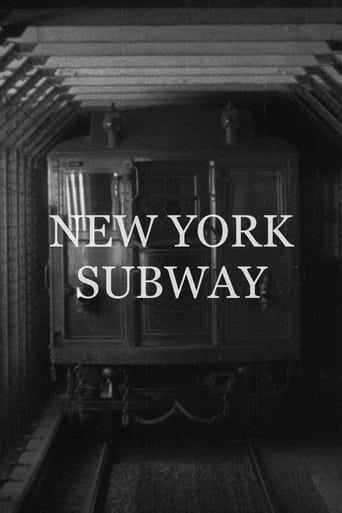Michael_Elliott
New York Subway (1905) ** 1/2 (out of 4) When people think of G.W. Bitzer they think of him being the cinematographer for D.W. Griffith on his landmark pictures but before teaming up with the future legend, Bitzer made a career out of being a director. This 5-minute film is such an example. There's really not too much going on but we see footage being shot of a train as it goes through the tunnels and stopping at various points to pick up more people. Yes, that's all that happens for five-minutes but it's important to remember that movie crowds back in the day loved movies with trains. If you start watching these early pieces of cinema you're going to notice a lot of movies deal with trains in regards to story lines or simply showing how they work or move. For the most part this is a pretty dull short because we just keep seeing the same thing over and over for the entire running time. What makes the film worth viewing is that it gives us a great look at the train system back in 1905. Sure, Hollywood could re-create this today using CGI but why bother when you have the real thing right here on full display? I really enjoyed seeing the structure of the tunnels, the look of the train and of course the type of clothing that people were wearing back in the day. Fans of early cinema and those who just want to see 1905 should certainly check this out but others might want to stay clear. It's also worth noting that the cinematography is rather remarkable considering the era.
MartinHafer
This is one of 50 films presented on the DVD collection "Treasures from American Film Archives (2000)". It consists of mostly ephemeral films that somehow missed destruction over the years and which have been preserved by 18 different sources."New York Subway" is one of the earliest pieces of footage showing the New York subway. It's unusual in that the footage appears to have been taken from one train as it closely followed another through the tunnels--giving you a driver's view of the system. While it's far from exciting, the film has a definite historical value and was amazingly high-tech for its day. However, the camera is stationary on the train itself--with no panning or zoom shots, as they had not been in use yet in 1905. However, it's really hard to rate such a non-commercial film, so I will not vote on this one.
Snow Leopard
Although early cinematographer G.W. 'Billy' Bitzer is usually remembered for his work on D.W. Griffith's epics, this short feature - a solo effort by Bitzer - might be an even more impressive display of his skill. To accomplish such clear, detailed photography of a moving underground subject, given the equipment of the time, must have taken considerable talent and planning.The end effect seems straightforward in itself: the movie shows a view of a subway car, taken from another one, as it makes a trip through the tunnels under New York City. On a few occasions, another car carrying the lighting, running along a parallel track, can be glimpsed. But the timing, the coordination, the light level, and many other challenges involved make it a real achievement for its day.The 'ride' effect itself is interesting for a while, at least for those of us with limited experience riding subways. There is not all that much to see, so that after a while it's mostly more of the same thing, but every detail that there is to see is rendered clearly. It's hard to see how it could have been improved upon.
